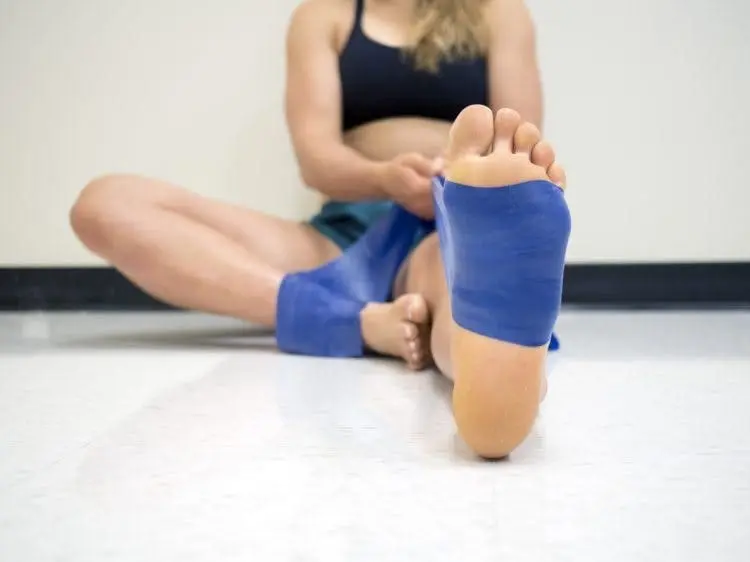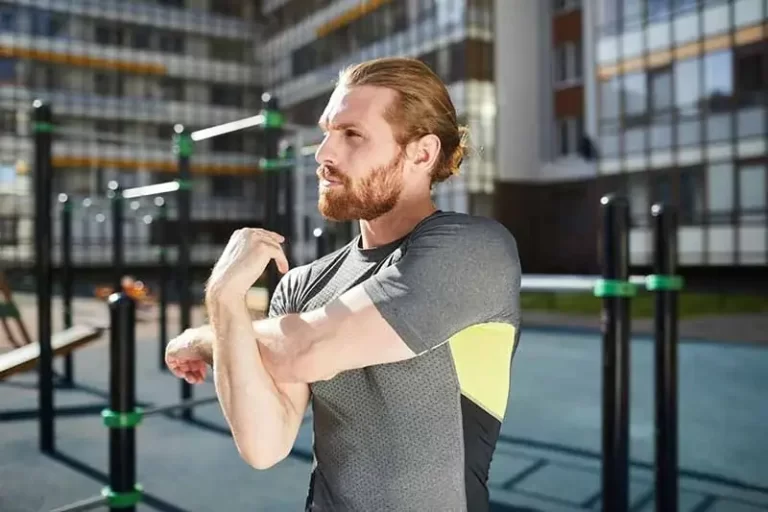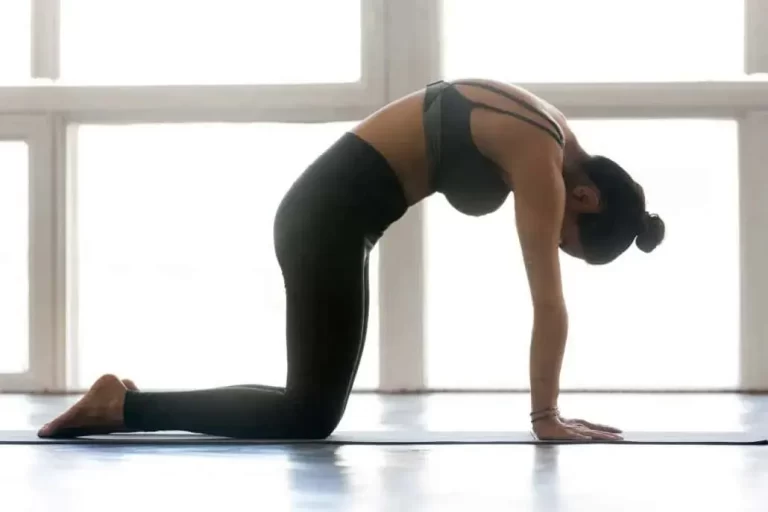16 Best Foot Drop Exercises
Foot drop exercises are necessary for managing and recovering from this condition because they strengthen lower limb nerve function and muscle strength. In this article, we will try to decrease foot drop and increase mobility through a range of exercises, helping persons who have this problem to lead better lives.
Introduction:
A medical condition called foot drop, or drop foot, is represented by difficulty lifting the front portion of the foot. Numerous underlying conditions, such as neurological diseases, muscular weakness, and nerve damage, could be the cause. Foot drops may affect a person’s quality of life and range of motion by making them crash, fall, and have difficulty walking.
Thankfully, there are rehabilitation methods and exercises made specifically to help control and reduce foot drop symptoms. These exercises are meant to increase flexibility and coordination while strengthening the muscles used in foot lifts.
These exercises, when done on regular schedules under the supervision of a physical therapist, can be an important component of a complete treatment plan for people with foot drop. This guide will take you through a variety of stretches and exercises that are specifically intended to treat foot drop and improve the affected foot and ankle’s strength, mobility, and general function.
Resuming your usual routine of exercise may require some time, and initial results may not be apparent right away. Still, following a foot issue, the best way to achieve positive both short- and long-term results is a gradual return to regular activity.
A Foot Drop: What Is It?
Foot drop is a condition that makes it difficult to raise the front of the foot and toes. Because the person is more likely to fall if their foot drags or their toes stay on the ground, it frequently causes walking difficulties. Fortunately, there are several methods available for restoring the strength and range of motion in your feet, and one of the best ones is to engage in foot drop exercises.
In some cases, specific exercises that strengthen the muscles in the foot, ankle, and lower leg can help alleviate the effects of foot drop. Since exercise has the potential to stimulate and reorganize the brain, it is an effective strategy to prevent foot drop following a stroke or brain injury. Exercise is necessary for improving range of motion, lowering muscular stiffness, improving balance and gait, and preventing injuries.
To treat foot drop, you may work with a physical therapist who can help you start strengthening the muscles in your ankle, leg, and foot. Your physical therapist will likely advise you to continue doing strengthening exercises at home on your own since recovering from foot drop may take some time. By strengthening the weaker muscles, you can restore normal function and resume walking normally.
Causes for Foot Drop:
Foot drop can be caused by three primary causes of weakening muscles or nerves:
- Nerve Damage
The nerve that provides information to the muscles that raise the foot is called the peroneal nerve. The most prevalent cause of foot drop is injury to the peroneal nerve. The nerve is easily damaged because it is close to the surface and wraps around from the back of the knee to the front of the shin. Sports injuries, hip or knee replacement surgery, leg casts, childbirth, and even crossing one’s legs can all harm the peroneal nerve.
- Muscle Disorders
Foot drop may also be caused by a condition that weakens or decreases the muscles over time. These conditions can include polio, amyotrophic lateral sclerosis, and muscular dystrophy.
- Illnesses of the brain or spine
Foot drops can also be caused by neurological conditions. Multiple sclerosis (MS), cerebral palsy, and stroke are possible conditions.
Which symptoms are associated with foot drop?
A problem known as “foot drop” occurs when a person has trouble elevating their feet. Symptoms that are frequently related to foot drop include:
- Weakness in the foot and ankle
Ankle and foot weakness or instability may result from weakening of the muscles that perform dorsiflexion or elevating the foot.
- Foot dragging
A foot that is difficult to raise may drag its toes or the foot along the ground when walking.
- A high-stepping manner
When walking, climbing stairs, or stepping over obstacles, people with foot drop may adopt a high-stepping gait pattern to make up for the fallen foot by lifting their thighs higher than normal.
- Slapping of the feet
Due to a lack of control over foot movement, the foot may slap against the ground with every step when walking.
- Sensation or numbness
People may feel tingling or numbness in their lower leg or foot, depending on the underlying reason for foot drop.
- Falling or stumbling
Due to their foot not lifting as they would expect, people with foot drop frequently trip or stumble.
It is vital to remember that foot drop is a symptom and not a specific illness. Therefore, the proper therapy of foot drop depends on determining and treating its underlying cause. It’s best to speak with your doctor for a full assessment and diagnosis if you’re having symptoms of foot drop.
How Is Foot Drop Helped by Physical Therapy?
It can be challenging to raise your toes and the top of your foot toward the ground if you have foot drop, also referred to as drop foot. Dorsiflexion is the term for this movement, which is essential for proper gait and balance.
Your muscles need to interact with your brain to know when to contract and relax to move. When the brain regions responsible for producing these signals are damaged due to a brain injury or stroke, foot drop may result. However, damage to the muscles or nerves in the lower leg that directly conduct dorsiflexion, or to the nerve roots originating from the lumbar spine (more specifically, L4-L5), can also cause foot drop.
Foot drop exercises help to strengthen the surrounding muscles and rebuild the brain to improve your ability to send the right signals to your brain to move your foot. Modifying, or neuroplasticity, is a process that is necessary for foot drop recovery.
Therapy exercises and movement rehabilitation provide the brain with the stimulation it needs to regain the ability to dorsiflex. To give the brain the repetition it needs, most physical therapists give their patients a sheet of foot drop exercises to perform at home.
Foot Drop Exercises:
Here are the best foot drop exercise,
Ankle Plantarflexion
Plantar flexion is a movement in which you point your toes down toward your heel while strengthening your ankle with a resistance band.
- With your heel resting on the ground and your other leg lying comfortably, take a seat on the floor with one leg bent at the knee.
- With both hands, grasp the ends of the band as you loop it around the front of your foot.
- Release the pressure by slowly pointing your toes forward and then back.
- Then return to your neutral position.
- Then relax.
- Repeat this exercise 5 to 10 times.
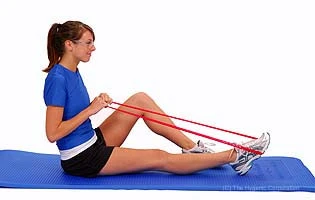
Ankle dorsiflexion
By pulling your toes toward you (dorsiflexion), you can flex your ankle with a stretch band during this exercise.
- Take a long Sitting position on the mat with your legs straight in front of you.
- After attaching the band around a table or chair leg, wrap it around one foot.
- Point your toes slowly in your direction, then take a step back and start again.
- Then return to your neutral position.
- Then relax.
- Repeat this exercise 5 to 10 times.
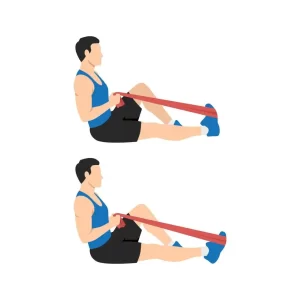
Assisted Toe Raises
- To begin, place the foot that is affected on top of the foot that is not affected.
- Next, raise your foot with the unaffected foot.
- Make thoughtful, slow movements to help in brain stimulation.
- You can try to dorsiflex actively with the assistance of your other foot, or you can do it passively with your foot fully relaxed.
- Then return to your neutral position.
- Then relax.
- Repeat this exercise 5 to 10 times.
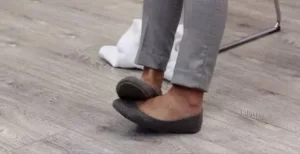
Golf ball roll exercise
- Take a chair and sit up straight with your feet flat on the floor.
- A golf ball must be positioned near the feet on the ground.
- To move the ball around, plant one foot on it and apply as much pressure as is comfortable.
- The ball needs to be massaging the bottom of the foot.
- For the next two to three minutes, keep moving the ball around.
- Then return to your neutral position.
- Then relax.
- Repeat this exercise 5 to 10 times.
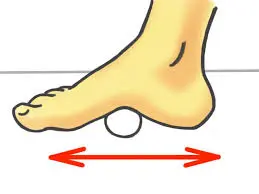
Toe curl, point, and raise
- Grab a chair, sit up straight up, and place your feet flat on the ground.
- Elevate the heels while keeping the toes planted in the ground.
- Stop when your feet are the only parts of your body that remain on the ground.
- After a few seconds of maintaining this position, step down from the heels.
- Just the tips of the big and second toes should touch the ground during the next stage, with heels raised and toes pointing downward.
- Hold this posture for a few seconds.
- Rise your heels and curl them inwards so that during the third stage, only the tips of your toes touch the floor.
- Maintain your posture for a short while.
- Then return to your neutral position.
- Then relax.
- Repeat this exercise 5 to 10 times.
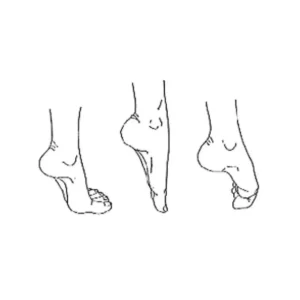
Toe splay exercise
- Sit in a chair with a straight back and place your feet gently on the floor.
- Extend your toes apart as widely as you can without straining.
- Hold this position for a few seconds.
- Then return to your neutral position.
- Then relax.
- Repeat this exercise 5 to 10 times.
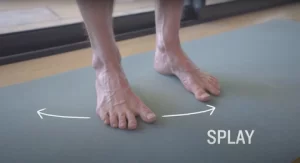
Standing Calf Raise exercise
- Place yourself with your feet shoulder-width apart and your toes pointed forward on a yoga or exercise mat.
- If your mat is not available, you can perform standing calf raises on the floor.
- Hold your shoulders down, your back straight, and your abs tight.
- Keep your knee extended, but not locked, as you raise your heels gradually.
- Make sure your feet are as near to the floor as conceivable.
- For a few seconds, maintain this posture.
- Lower your heels back to the ground.
- Then return to your neutral position.
- Then relax.
- Repeat this exercise 5 to 10 times.
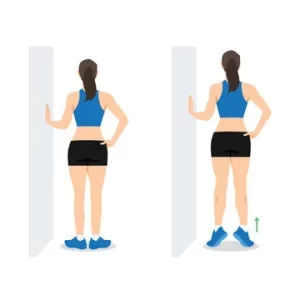
Alphabet write exercise
- Start with the seating position on the chair.
- Lift your foot a few inches and use your big toe to write the alphabet in the air starting with the capital letters.
- Use long, going-down phrases.
- Once you’ve finished writing the alphabet, move on to lowercase characters.
- Then return to your neutral position.
- Then relax.
- Repeat this exercise 5 to 10 times.

Toe curls exercise
- Take a seat with your heels under your knees (you can also stand).
- Make sure your legs and feet are parallel to each other and point forward at the toes.
- Set out the towel and place a level foot on it.
- The towel will be shifted in your direction.
- Keep your heel down as you twist your foot back and raise your toes.
- Having your heel on the towel, extend your foot evenly along both sides and the middle to get your foot as far out on the towel as possible.
- Maintaining your heel steady, pinch the towel in with your toes and arch.
- Pull the towel in your direction.
- Draw a wide circle below the arch area using all five of your toes on each side of the foot.
- You will only be able to move a small area of the towel each time you draw back and extend.
- Then return to your neutral position.
- Then relax.
- Repeat this exercise 5 to 10 times.

Marble pickup exercise
- Place both feet flat on the floor and sit down straight on a chair.
- One empty bowl and one with at least twenty marbles in it should be placed on the ground in front of the feet.
- By applying the toes of only one foot, place each marble into the empty bowl.
- Then return to your neutral position.
- Then relax.
- Repeat this exercise 5 to 10 times.
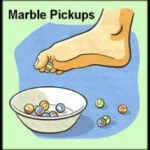
Towel Stretch
- This is a simple stretch that you can do in bed or while seated on the floor.
- Legs extended in front of you, take a seat on the floor or your bed.
- Behind both heels of your feet, place a rolled-up towel and hold onto both ends.
- With your knees straight, gently pull the towel in your direction.
- Hold for a few seconds.
- Then return to your neutral position.
- Then relax.
- Repeat this exercise 5 to 10 times.
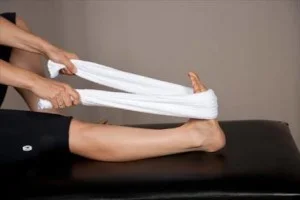
Heel Raises
- Start by laying your feet flat on the ground and lift your heels.
- Next, point your toes and lift your heels off the floor.
- Try to keep your feet in the proper neutral line by pushing through your first and second toes firmly, being careful not to let your ankles shift outward throughout the heel lifts.
- You should be using the muscles in your calf and lower back.
- Then return to your neutral position.
- Then relax.
- Repeat this exercise 5 to 10 times.
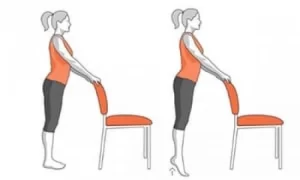
Inversion and eversion of the ankle
For eversion,
- To start this active foot drop exercise, place your injured foot flat on the ground.
- Next, stretch the tips of your toes and the outside of your foot, then settle back down.
- Focus on keeping the movement separate from your foot and ankle to prevent overreacting with your leg.
- Then return to your neutral position.
- Then relax.
- Repeat this exercise 5 to 10 times.
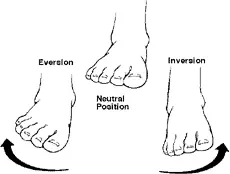
For inversion,
- Beginning in the same position, raise your toes and the inside edge of your foot toward your body’s midline, then lower them back down to complete the ankle inversion.
- Then return to your neutral position.
- Then relax.
- Repeat this exercise 5 to 10 times.
Hip external and internal rotation
Even though this exercise primarily works the upper leg and hip, increased tone (stiffness) in the leg can also affect the foot, which helps with foot drop.
- This lower-limb workout should begin with a standing position.
- Next, start your afflicted leg inward toward your midline while externally rotating your hips.
- Then return to your neutral position.
- Then relax.
- Next, kick your injured leg as if you were kicking a ball to the side, or perform hip internal rotation.
- Then return to your neutral position.
- Then relax.
- Repeat this exercise 5 to 10 times.
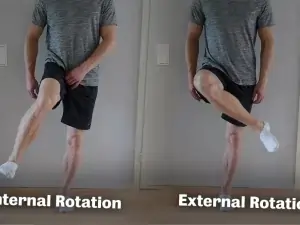
Single leg stance
- For support, hold a strong chair or countertop.
- Face the chair or tabletop and maintain it within reach.
- Elevate one foot off the ground while bending the knee to a comfortable position.
- The non-standing leg can be kept straight, slightly elevated, or bent depending on the patient’s comfort level and ability.
- Your main goal should be to maintain balance while engaging your core muscles.
- Avoid tilting or sloping to one side.
- Starting with a short moment of balance, gradually lengthen it as your strength grows.
- You can use the chair or countertop as support if needed but try to progressively minimize your dependence on it as you gain stability.
- Then return to your neutral position.
- Then relax.
- Repeat this exercise 5 to 10 times.
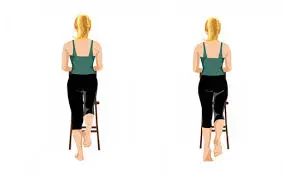
Ball lift
- Both feet should be flat on the ground as you sit in a chair.
- The size of a tennis ball, or something similar, should be placed on the ground in front of you.
- Put your legs out and grasp the thing between your feet, lifting it carefully.
- Lower gradually after holding for five seconds.
- Then return to your neutral position.
- Then relax.
- Repeat this exercise 5 to 10 times.
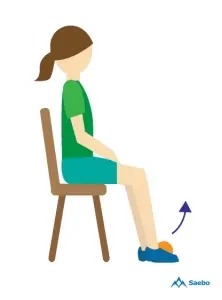
When working out, it’s helpful to remember the following advice:
- When you experience any kind of pain when exercising, stop immediately.
- Though you shouldn’t ever experience severe or sharp pain, it’s okay if the stiff muscles seem difficult to stretch.
Make sure to warm up and stretch before beginning the exercise. - Take breaks between your workouts.
- Following the protocol is important, as it outlines the correct number of repetitions for each exercise along with the necessary stretches and holds in between.
- When exercising, wear loose clothing that allows your body to move freely; keep away of anything too tight.
What indications suggest the healing of your foot drop?
An improvement in walking is the most obvious signal that foot drop is recovering. You may see a decrease in toe drag or a reduction in the amount of knee flexion required to take a step forward as you heal. These changes ought to give you improved balance and a decreased chance of falling.
Dorsiflexing or elevating your foot should be painless during the healing process, and any tingling or numbness should begin to go away. As the nerves regenerate, there can even be contractions in the muscles. Additionally, the calf muscle may get stronger or larger.
The reason for the foot drop and the degree of any nerve injury determines how well a person heals. While some people will fully recover, others will always have a footdrop.
Will my feet drop and I be able to run again?
It’s necessary to realize that every person’s rehabilitation from foot drop can be unique. It might require patience, persistence, and time for rehabilitation. You have the best chance of regaining function and possibly even being able to run again without the help of equipment if you cooperate closely with doctors and follow their advice.
If you have the right instruments or equipment, you could be able to walk, run, and even hike with greater flexibility and independence.
Summary
Foot drop, also referred to as dropped foot or drop foot, is the inability to elevate the front of the foot because the muscles and nerves responsible for doing so are weak or paralyzed. Many foot drop exercises can improve muscle strength and range of motion to enable more comfortable walking. Foot drop is a symptom of a more serious issue or medical condition; it is not a disease in and of itself.
Foot drop can be identified by the way it alters your gait. When walking, a person with a foot drop may drag their toes along the ground because they are unable to raise their front foot with each stride. Instead, they may lift their knee higher or swing their leg in a wide arc to prevent tripping or dragging their toes. This is a treatment for foot drop problems and is referred to as step page gait.
FAQ:
What exactly is the main cause of foot drop?
When the muscles in your foot are weak or paralyzed, you are unable to raise the front part of your foot, which is known as foot drop. This is a common symptom of peroneal nerve damage.
Is it possible to correct foot drop with exercise?
Your knee and ankle joints can remain flexible and your leg muscles can be strengthened with exercise. These exercises may help with foot drop-related gait problems. To prevent tightness in the heels and calves, it is imperative to participate in stretching exercises.
Is it possible to get physical therapy for foot drop?
Yes there are many benefits to receiving physical therapy for foot drop.
Maintaining the strength and range of motion in your calf muscles and ankle and knee joints can be helped by physical therapy. Gait training is a further benefit that physical therapists can provide to help people with abnormal gait walk more gracefully and efficiently.
What’s the recovery time for foot drops?
Depending on the exact reason and extent of nerve injury, recovery from drop foot can take a variety of durations. Nerve injury recovery can happen in as little as three months, but neuron loss associated with multiple sclerosis (MS) might take up to twelve months.
Can somebody walk with a dropped foot?
Foot drop patients frequently drag their toes when walking as a result of weakness or paralysis. In addition, they might need to raise their knee higher than normal to prevent tripping their toes. This is a potentially dangerous path to walk in case you trip and fall.
Does foot drop continue permanently?
Although it can be permanent, foot drop can also be temporary at times. To support and stabilize your foot if you have foot drop, you might have to put on an ankle and foot braces.
What kind of root results in foot drop?
Due to the weakness of the anterior compartment musculature, a lesion of the L5 root, lumbar plexus, sciatic nerve, common peroneal nerve, or deep peroneal nerve may cause foot drop. Lack of ability to walk as before is the presenting symptom.
For what duration does foot drop heal?
Yes. While some foot drop cases clear up in a few months, others might take longer to heal if there was a significant nerve injury. Once the cause and extent of the nerve damage have been determined, you will receive extra details.
Is the foot drop serious?
Foot drop can improve on its own or with treatment, but it can also be permanent. Muscular weakness is caused by muscular dystrophy, spinal muscular atrophy, or a condition called motor neuron disease.
In foot drop, which nerve is injured?
Foot drop is a gait issue that can result from peroneal nerve injuries, along with numbness, tingling, pain, and weakness.
With a drop foot, how would anyone walk?
Brace To help control foot drop, a brace known as an ankle foot orthosis (AFO) is frequently used. The brace is put on around the foot and lower leg and is usually constructed of plastic. While the majority of AFO braces keep the ankle and foot in a fixed position, others feature an adjustment that permits ankle movement.
Is it possible for foot drop to develop overnight?
Depending on the exact cause of the condition, foot drop symptoms may change and show gradually or suddenly. Early symptoms can appear before the condition fully develops.
Can foot drop be alleviated by walking?
The easiest technique to strengthen your foot to walk better with foot drop, aside from using an AFO or foot drop brace, is to work out every day. If you want to see your foot muscles get stronger, you must exercise them consistently, just like any other muscle.
Does foot drop cure itself?
Foot drop can sometimes be permanent, although it can also sometimes improve on its own and with therapy. Less frequently occurring reasons for foot drop include hereditary diseases such as Charcot-Marie-Tooth syndrome. muscular weakness brought on by motor neuron disease, muscular dystrophy, or spinal muscular atrophy.
Does a dropped foot affect a person’s capacity to balance?
Walking with the leg dragging the front of the foot is known as “foot drop.” Walking without support may become challenging due to balance loss.
References:
- October 17, 2023, Sankhla, D. Strengthen your foot and ankle with these 5 top foot drop exercises. Samarpan Clinic for Physiotherapy. Foot Drop Exercises: https://samarpanphysioclinic.com/
- GoodRx – Inaccuracy (n.d.). Exercises for feet dropped: https://www.goodrx.com/well-being/movement-exercise
- Hoffman, H. Oct. 17, 2022. Six Foot Drop Exercises to Help You Stand Up Again Saebo, Saebo, https://www.saebo.com/blog/foot-drop-exercises-to-regain-your-footing/
- National Foot Drop Awareness: FAQs (n.d.). Awareness of National Foot Drop. FAQs at https://www.nationalfootdropsociety.com
- Image 1, Performance Health Academy (n.d.) presents Thera-Band Loop Ankle Plantarflexion in Long-Sitting. When sitting for extended periods, the plantar flexion of the ankle is facilitated by the theraband loop.
- Image 2, April 16, 2023: Putra, L. Get the Man performing a dorsiflexion stretch with a resistance band. Ankle exercise 22915229 is royalty-free. The image “Man performing Resistance Band Dorsiflexion Exercise: Stretch Ankle Exercise” can be found on Vecteezy.
- Image 3, November 17, 2022; Cscs, A. T. P. D. N. Ten Foot Drop Exercises to Help You Stand Up Confidently Again. Rehab Flint. Foot Drop Exercises: https://www.flintrehab.com/
- Image 13, Online Store: 14541879 (n.d.). 14541879.html is the product detail at https://salepeaket.live.
- Image 14, On December 13, 2023, Bariya, D. Internal rotation of the hips: range of motion, muscles used, exercise. Mobile Clinic for Physiotherapy. Google Vignette: https://mobilephysiotherapyclinic.in/hip-internal-rotation/
- Image 15, As of February 14, 2020, A. It is not appropriate to squat on two legs if you are unable to stand on one. All-inclusive Medical Care. If you can’t stand on one leg, you shouldn’t be squatting on two, according to https://theccmc.com/
- Image 16, 2023 November 14 Hoffman, H. 8 Foot Drop Exercises to Help You Regain Your Balance – Saebo. Saebo. https://www.saebo.com/blog/8-foot-drop-exercises-to-assist-you-regain-your-balance/

